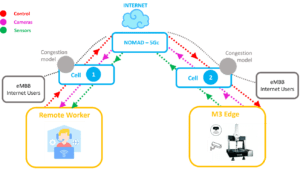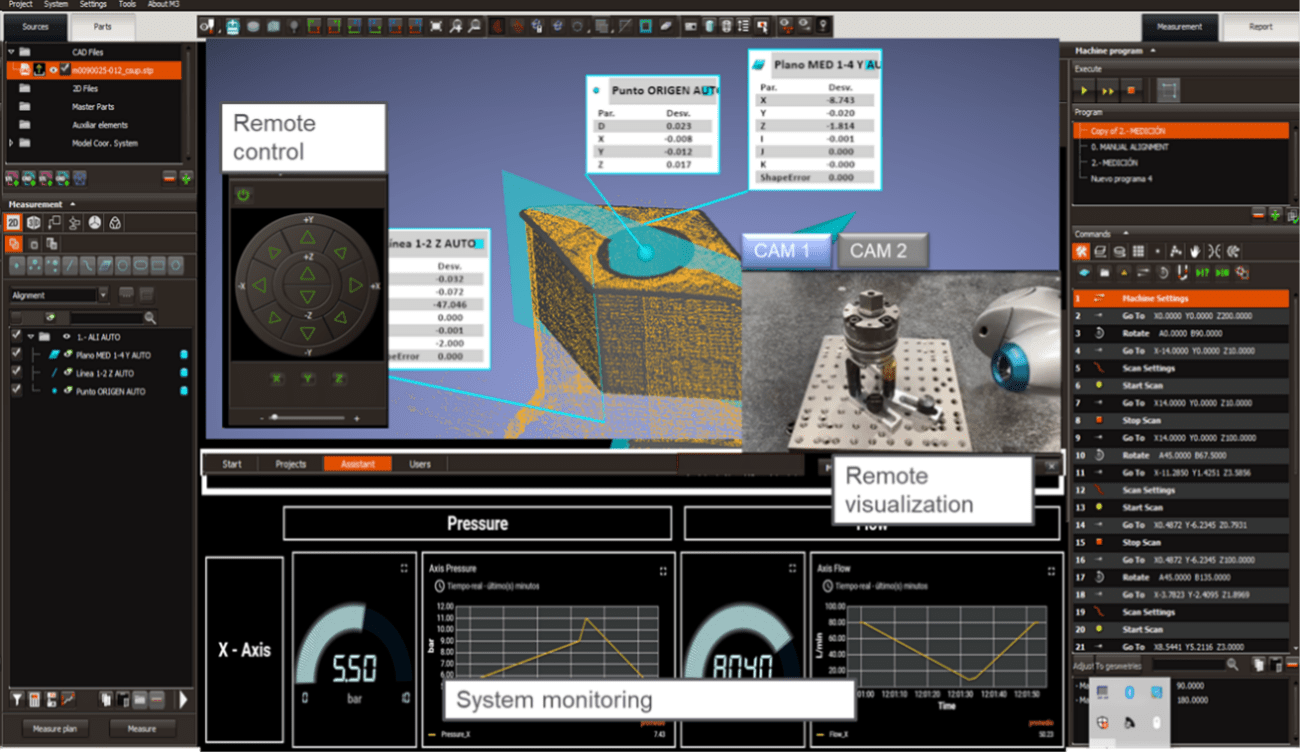
Keep up to date with our innovative initiatives.
Sign up here
Abstract:
The high-precision remote metrology use case within the UNICO i+D 6G 6GSMART project uses 5G connectivity to enable metrologists to monitor and operate coordinate measuring machines (CMMs) remotely, ensuring process accuracy and quality. Using two cells, one connected to the CMM that transmits data from cameras, sensors, and point clouds, and another cell connected to a station for the remote operator with virtual control over the CMM, measurements with high-quality accuracy were achieved. Tests conducted under the conditions of a public 5G network show that with proper bandwidth allocation, it is possible to ensure efficient and secure remote metrology operations, improving quality control in manufacturing with high flexibility and speed.
While addressing the challenges that manufacturing faces regarding globalization, the human-centric approach is remarkable in that it enables manufacturing organizations to match and fulfil customers’ product requirements with highly automated production, the highest quality, and low time investment. In the Industry 5.0 scenario, metrology is facing similar challenges. Companies dedicated to manufacturing parts and components are receiving dimensional quality requirements and tolerances from large companies. Metrology is the key to achieving compliance in terms of quality control.
Today, metrology is implemented using Coordinate Measurement Machines (CMMs) that are deployed on the factory floor and require specific high-performance software for capturing and analysing point clouds of the measured parts, all operated manually by an expert metrologist next to the CMM.
Nowadays, the measurement process can be performed remotely with a desktop, which allows the remote performance of certain process steps. However, it does not allow operating the machine remotely or executing any action that has not been integrated into the measuring plan and programming.

Figure 1. Current remote desktop operation for measurement process
The High precision remote metrology Use Case in the UNICO i+D 6G 6GSMART project, using public 5G connectivity, allows a new advanced service in the metrological sector where a metrology expert can connect remotely to a CMM and, supported by sensors and a video stream of the CMM, can operate the machine based on real-time operating information as if he was physically by the machine. This inspection and monitoring of the process is essential both to guarantee the accuracy of the measurement and the safety of the process itself.

Figure 2 New 5G based remote metrological process
The design of this new 5 G-based remote metrological implies the provision of remote-control capabilities (Module 3 – Control) in the shape of remote visual access (Module A – Cameras) and remote monitoring of key service indicators (Module 2 – Sensors), which means three different data streams. Sensors and cameras from the M3 edge are placed at the CMM to the remote worker, and the control is placed from the remote worker to the M3 edge.

Figure 3. Data flows.
For the use case implementation, two different stations were prepared: one with Robotlink and DataAssembler connected to the CMM, capturing and transmitting video and data from the cameras and sensors as well as capturing the point cloud of the measured part, and another one, the remote operator station receiving the status of the CMM measuring process with an M3 installation adapted with a virtual joystick to allow remote intervention if any alert is raised.
On the other hand, these two stations were connected through the Nomad 5G network by Neutroon, emulating a public 5G network. To do so, additional traffic in the same CMM and remote worker cells was generated to emulate realistic network conditions to perform the different assessments of the Use Case, where a complete scan of a test part was performed.
The evaluation process for the high-precision remote metrology use case was defined based on different levels of network congestion as well as interference and prioritisation levels while trying to preserve specific levels for the frequency and latency of the three modules (cameras, sensors and control). In addition to these network requirements, a particular value related to Quality of Experience was monitored to ensure that the remote control over the CMM conforms to the metrological Quality of Service requirement, which was aimed at achieving a manual positioning error of the CMM in lower than 0,1 mm using the remote control of the CMM, the probe type tool and the remote viewing cameras.

Figure 4. Remote worker M3interface with access to the cameras and the sensors
Focusing on the TDD 7-2 configuration, optimized for eMBB traffic and taking into account 6 internet users, when changing the bandwidth part reservation in the CMM cell and the remote worker cell, the main results are shown in the next table where we can see how a 30% reservation in the CMM cell and a 10% reservation in the remote worker cell is enough to guarantee the remote operation of the CMM for all the application configurations.
| TDD pattern | 7-2 | 7-2 | 7-2 | 7-2 |
| Sampling Period (ms) | 50 | 30 | 30 | 20 |
| Sensor Speed (m/s) | 50 | 30 | 20 | 10 |
| ρCMM = 0.1 , ρRemW = 0.1 | No | No | No | No |
| ρCMM = 0.2 , ρRemW = 0.2 | No | No | No | No |
| ρCMM = 0.3 , ρRemW = 0.3 | Yes | Yes | Yes | Yes |
| ρCMM = 0.3 , ρRemW = 0.1 | Yes | Yes | Yes | Yes |
Based on the experimental results, public 5G networks supporting 5GNR bandwidth parts can enable remote metrology operations as it guarantees high quality in a flexible, fast and secure way for dimensional quality control in manufacturing.
A more detailed description of this work will be presented at the IEEE WCNC 2025 conference in Milan:
Domènech, S. M. Darroudi, F. Canellas, D. Camps-Mur, S. Rodriguez, A. Gonzalez, O. Lázaro, T. Ventura, “On the Application of 5GNR Bandwidth Parts to Enable Remote Operations in Industrial Metrology”, IEEE WCNC 2025, Milan, Italy.
A demonstration of this use case can be found in the following video:
Author: Toni Ventura Traveset, Managing Director de Datapixel (Innovalia Group)